Getting your snowmobile’s track adjusted correctly doesn’t have to be complicated. In this guide, we’ll show you the tools, step-by-step instructions, and troubleshooting tips for all major brands — Polaris, Ski‑Doo/Lynx, Arctic Cat, Yamaha, and more. If you do it right, your snowmobile will run great quickly. Why Track Tension Matters Track tension directly affects […]
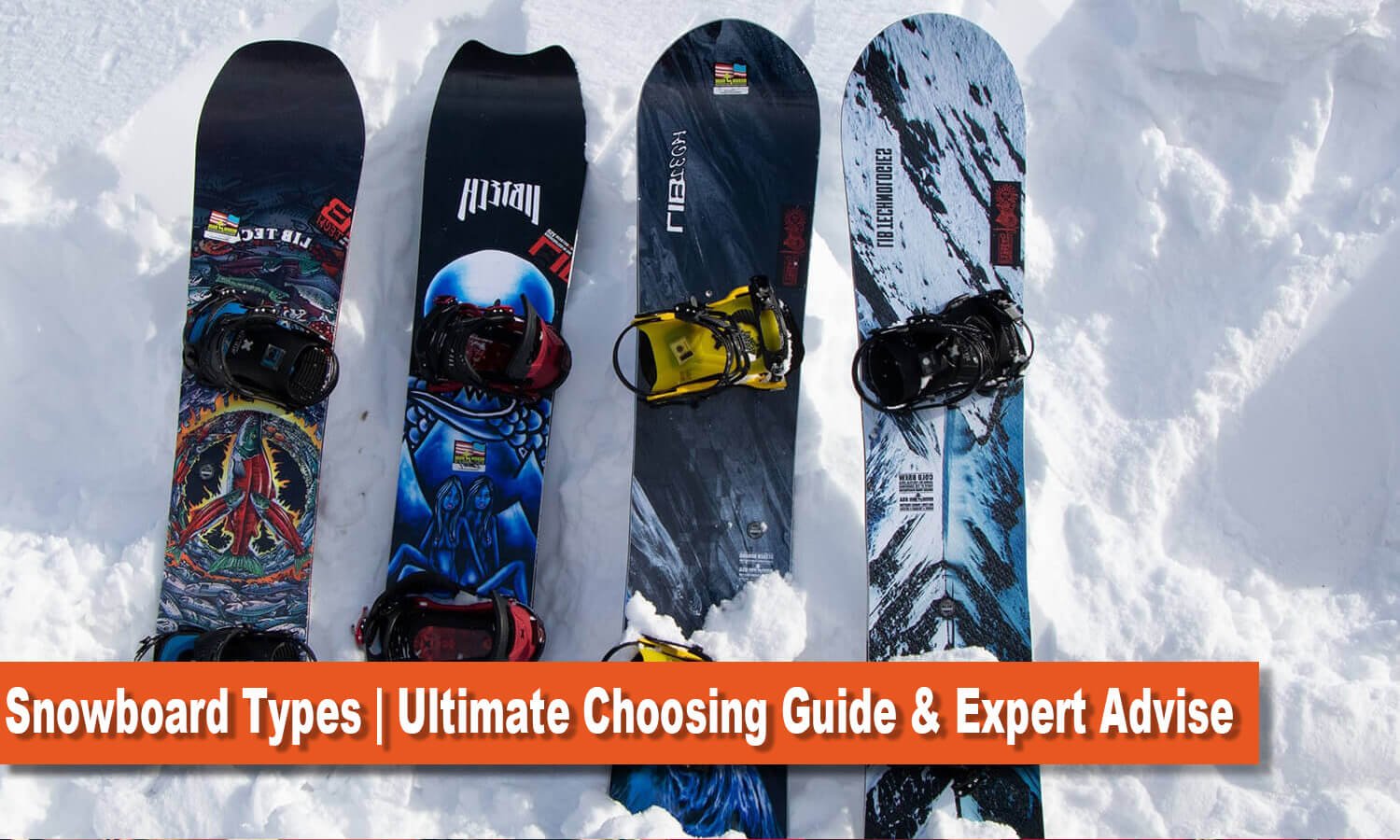
Snowboard Types | Ultimate Choosing Guide & Expert Advise
Snowboards are all different, made for different ways of riding in other places. Picking the right snowboard types can make learning simpler and riding way better. In this guide, we'll discuss the various types of snowboards, exploring what makes them distinct, including their shape, flexibility, and camber/rocker profiles. By the time you're done reading, you'll know which board is right for how you ride and how good you are.
Table of Contents
Main Snowboard Types
All-Mountain Boards
All-mountain boards are do-it-all snowboards for riding anywhere on the mountain. They often have medium flex and a hybrid camber profile for stability and versatility.
All-mountain boards are the jack-of-all-trades. They’re made to handle groomed runs, some park tricks, and even a bit of off-piste riding. Typical features include a directional or directional twin shape – meaning the board may be slightly longer in the nose than the tail, but can often ride switch like a twin.
The flex is usually mid-stiff (around 5–7 on a 10-point scale), giving a stable feel at speed while still being forgiving. Most all-mountain boards use a wood core (poplar or aspen, for example) with fiberglass layers for strength and pop. This construction provides a lively yet dampened ride.
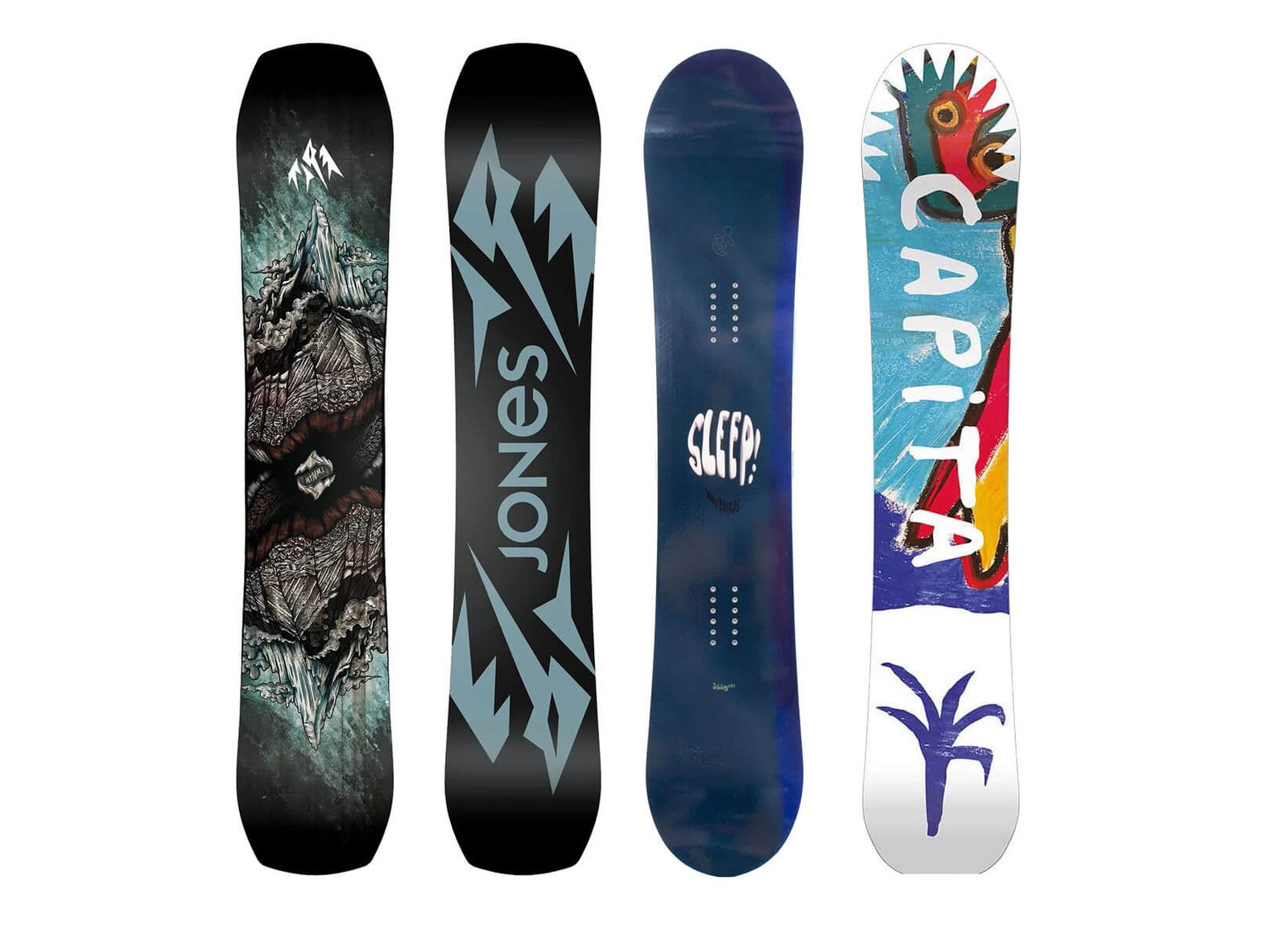
all mountain boards
- Shape: Directional or directional twin (sometimes true twin)
- Flex: Medium to medium-stiff for a balance of stability and playfulness
- Camber/Rocker: Often cambered or hybrid (camber underfoot with rocker at tips) for solid edge grip and float
- Terrain: Designed for all terrain and conditions – groomers, bumps, and light off-piste
- Best For: Beginners through advanced riders who want one board that does everything
All-mountain boards are popular for good reason. Their versatile shape and medium flex make them a great first board for beginners, and they let riders explore the whole mountain without switching gears. You can carve hard on the frontside, pop small jumps, and even dabble in powder with a good all-mountain board.
The trade-off is that they’re not perfect at any one thing – they won’t float as effortlessly as a dedicated powder board, and won’t spin as easily as a super-flexible park board – but for general use they are fantastic.
Freestyle (Park) Boards
Freestyle or park boards are short, soft, twin-tipped boards built for tricks. They have extra flex for popping and twin symmetry for landing switch.
Freestyle boards – sometimes called park or jib boards – are made for jumps, rails, and skate-park tricks. They tend to be shorter, lighter, and much more flexible than all-mountain boards. Key characteristics include a true twin shape (symmetrical nose and tail) so you can land and ride equally well in either direction.
The flex is soft to medium (often around 1–4 on a 10-point scale for jib boards, slightly higher for jump/freestyle boards). This bendy flex gives a “pop” off jumps and makes presses (nose/tail balances) easier.
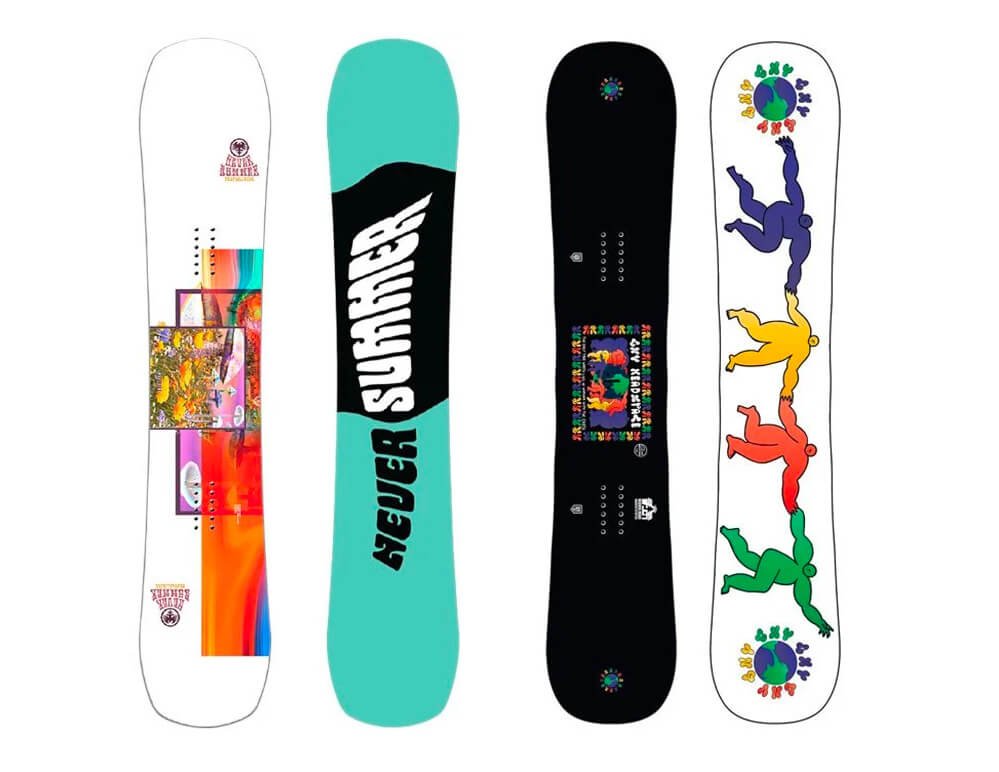
freestyle boards
- Shape: True twin (symmetrical) or very slight directional twin
- Flex: Soft to medium-flexing for easy maneuvering and pop
- Camber/Rocker: Varies by board; many park boards use full camber for maximum pop on jumps, though some use flat or rocker sections for a more forgiving feel
- Terrain: Terrain parks and street/urban features (halfpipes, jumps, rails, boxes)
- Best For: Tricksters and jumpers of all levels, especially beginners in the park who want an easy board to spin and press on
Freestyle boards feel very playful underfoot. When you load up the board by flexing it, it stores energy and “snaps” you into the next jump with extra pop. Because they are short and soft, however, they can feel a bit unstable when you try to ride fast on hard groomers.
But if your goal is to hit jumps and rails, the softer flex and twin shape make spins and switch riding a breeze. Advanced freestyle boards may use higher-end materials (like carbon stringers) to withstand big jumps, but they still prioritize flex and forgiveness over speed.
Freeride Boards
Freeride boards are stiff and directional, built for carving and steep terrain. They often have a tapered shape and hybrid camber for holding big turns and floating in powder.
Freeride boards are the opposite of park boards: they’re made for off-piste adventure, big mountain terrain, and high-speed carving. Most freeride boards are directional (nose longer than tail) or even tapered directional (with a wider nose than tail).
This design helps the board float in powder and lets you lean back naturally. Freeride boards usually have a setback stance (your bindings are mounted a few centimeters towards the tail) to keep the nose up in deep snow. The flex is generally stiffer than an all-mountain or freestyle board. A stiff flex provides stability at speed, so you won’t chatter on icy runs, and it gives powerful response when carving hard turns.
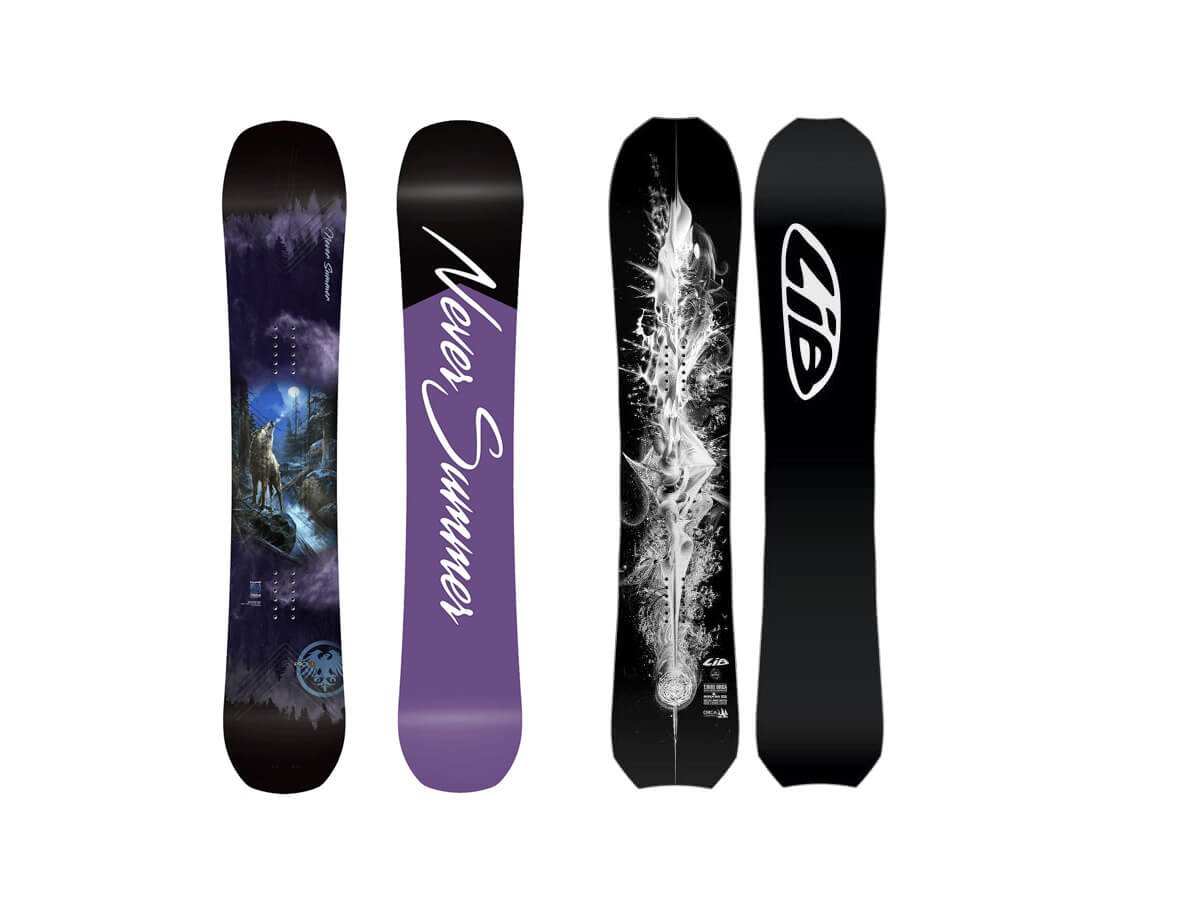
freeride boards
- Shape: Directional or tapered directional (wider nose, narrower tail)
- Flex: Stiff flex for stability and precise turning
- Camber/Rocker: Often hybrid camber/rocker or mixed profiles – camber underfoot for edge hold, rocker at tip for float
- Terrain: Ungroomed snow, steep runs, trees, and powder (backcountry and chutes)
- Best For: Expert riders who tackle big hills, carve hard, and explore off-piste terrain
Think of a freeride board as a carving machine that can handle a variety of tough conditions. The sharp edges and stiff flex let you carve nice clean turns on hard snow, while the directional shape helps keep you afloat in powder. Because they are stiffer, freeride boards don’t turn as quickly as park boards, but they soak up bumps better and charge hills with confidence.
For example, freeride riders will often choose a board with a firm flex to “lay down epic turns on steep, technical terrain”. These boards may also have extra materials (like carbon or bamboo rods) in the core to boost edge power without excessive weight.
Powder Boards
Powder-specific boards have very wide noses and a lot of rocker for maximum float. They let you “surf” on deep snow with a stubbier, directional shape.
Powder boards are a special breed, optimized purely for deep snow. Everything about them is tuned for floatation – meaning you stay on top of the snow instead of plowing through it. Powder boards are directional and often tapered: the nose is much wider and longer than the tail.
Many have a huge rocker (reverse camber) in the front and a deep setback stance, so the nose lifts up naturally in powder. They’re also typically a bit shorter than your all-mountain board, making them easier to whip around in the trees.
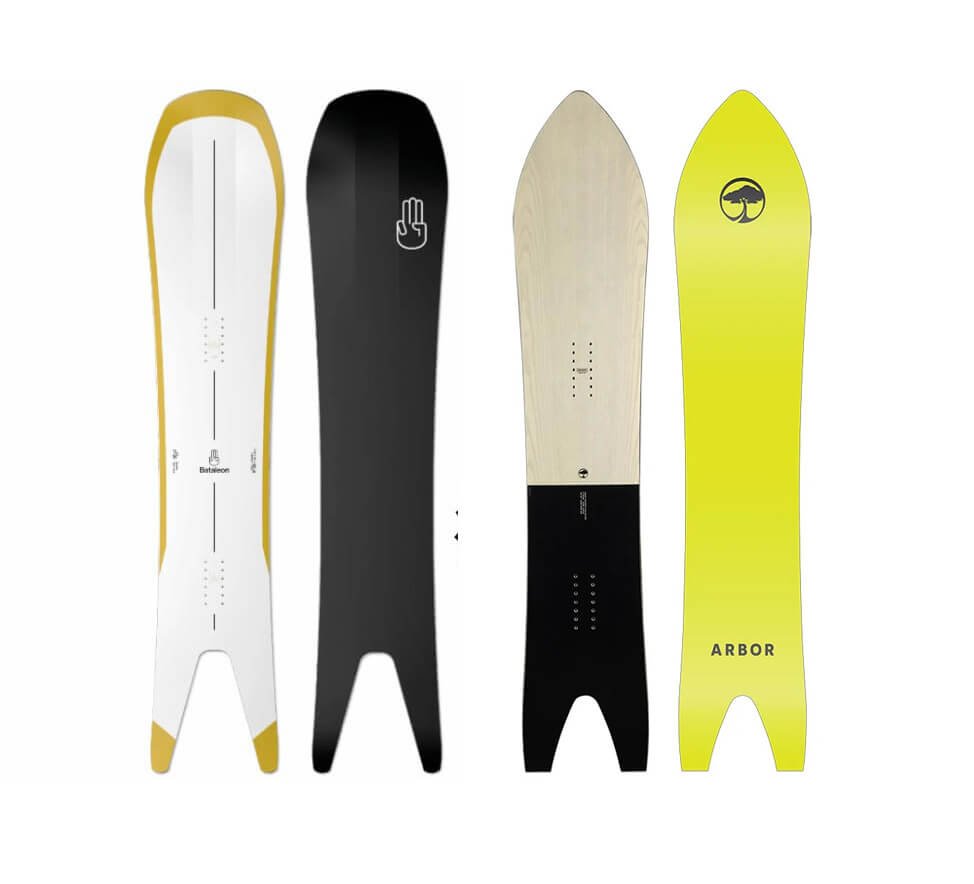
powder boards
- Shape: Directional, big wide nose and narrower tail; often tapered (wide tip, pinched tail)
- Flex: Medium (sometimes soft at nose) to help the board conform to uneven snow; soft boards float easier
- Camber/Rocker: Rocker-dominant or flat-to-rocker profile (usually flat under the back foot, rocker in the front)
- Terrain: Deep powder and untracked snow only
- Best For: Powder hounds and backcountry riders who chase fresh snow
Riding powder is like gliding on a cloud, and powder boards maximize that feeling. With the nose afloat and the tail down, you can throw big carving turns in the deep snow and feel like you’re “surfing” the mountain.
The downside is that powder boards perform poorly on hardpack or at speed – they can feel floppy and chatter on groomers because their tips are very loose. Some powder boards even have swallowtails or pin tails (notched or pinched tail shapes) to add even more float.
In short, if you dream of deep days and face shots, a powder-specific board will make that dream come true – just expect to swap back if you return to icy trail runs.
Specialized Snowboard Types
Volume-Shifted Boards
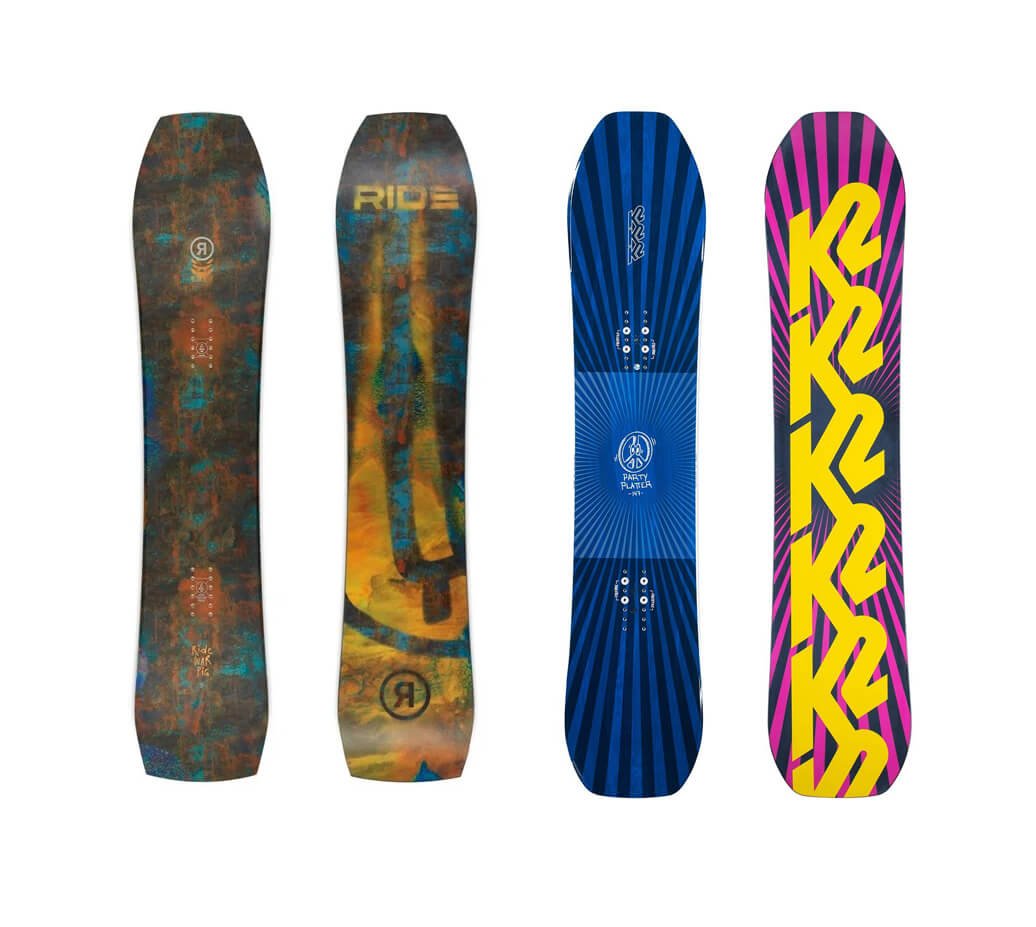
volume shifted boards
Volume-shifted boards are a newer and increasingly popular category. They’re shorter and wider than traditional snowboards, giving them the same surface area (and float) in a more compact shape. This design makes them extremely maneuverable in trees and excellent in powder, since the extra width provides plenty of lift while the short length allows for tight turns.
These boards often have directional or tapered shapes with rocker-dominant profiles, combining the float of a powder board with the playfulness of a freestyle shape. They can feel a bit different underfoot at first, but once you get used to them, they’re a fun and responsive option for riders who want something unique.
- Shape: Short and wide, usually directional or tapered
- Flex: Medium to medium-stiff for stability and control
- Camber/Rocker: Often rocker-dominant or hybrid for float
- Terrain: Powder, trees, and mixed terrain
- Best For: Riders who want a surfy feel and quick turns in deep snow or tight spaces
Volume-shifted boards aren’t as common as traditional all-mountain models, but they’re gaining traction fast—especially among riders who spend lots of time chasing powder or weaving through tree runs.
Splitboards (Backcountry Touring)
Splitboards let you climb uphill on untracked snow and then ride down. They split into two ski-like halves for skinning, then snap together for the downhill ride.
Splitboards are essentially freeride or powder boards that split in half lengthwise to form two “skis”. This allows you to climb (with skins) in the backcountry instead of taking a lift. Specialized bindings attach to touring plates or pucks that position your feet forward for climbing, then return to snowboard mode for the ride down. Once you reach the summit, you remove the skins and reassemble the two halves into a regular snowboard.
Aside from this gimmick, splitboards share features with freeride/powder boards: they are usually mid-stiff (to add support with the extra hardware), directional in shape, and have ample rocker in the nose for float. They’re often slightly wider than average to help in deep snow.
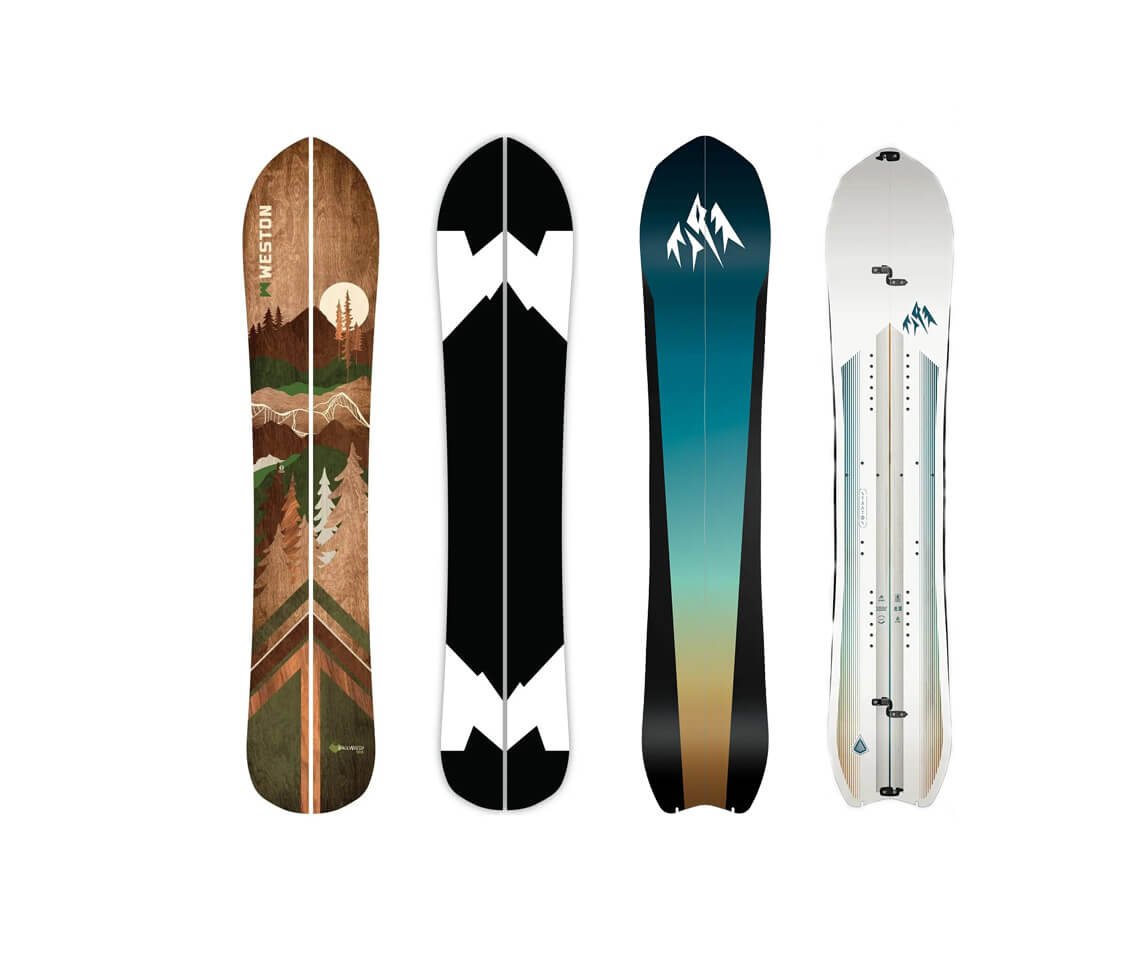
splitboards
- Shape: Directional (often similar to a freeride board, sometimes with taper)
- Flex: Medium to medium-stiff (rigidity helps stability on varied terrain)
- Camber/Rocker: Rockered or hybrid profile (to lift the nose in powder)
- Unique Feature: Splits into two halves for uphill touring with skins
- Terrain: Backcountry, untouched slopes, mountaineering climbs
- Best For: Experienced riders venturing into unpatrolled backcountry
Splitboarding is a niche, high-end activity. The upside is you get first turns on untouched powder. The downside is more cost and effort – splitboards are more expensive, and switching between ski-mode and board-mode takes time.
Note: Splitboarding requires additional gear (skins, avalanche equipment) and mountain safety knowledge, so it’s not recommended for beginners.
Alpine/Carving Boards (Bonus Category)
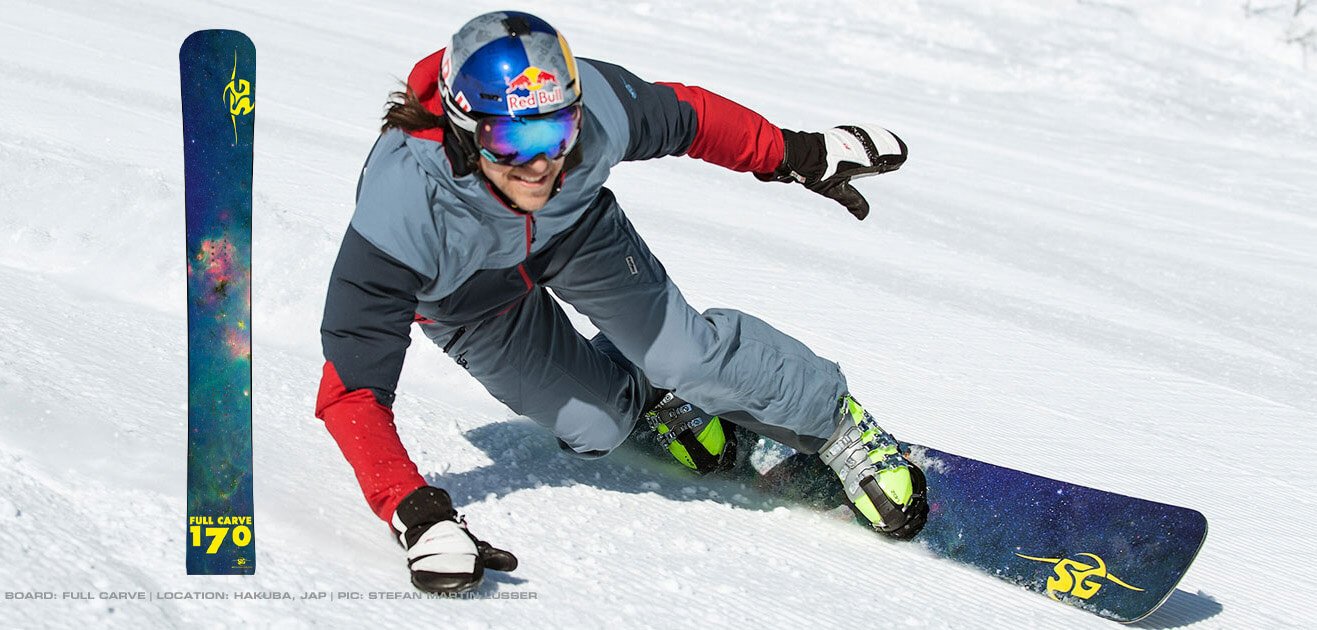
carving boards
For completeness, there are also alpine (race or carving) snowboards. These are very long, narrow, and extremely stiff boards used with hard boots and plate-style bindings (similar to ski systems). Their shape has a deep sidecut to carve huge arcs, and a full camber profile for edge grip.
These boards only ride in one direction – forward – and excel at high-speed carving on groomed slopes. They’re not common for recreational riders (or beginners) because they demand precision and don’t float in powder.
If your goal is Olympic-style racing or carving perfect GS turns, an alpine board is the specialty tool; otherwise, an all-mountain or freeride board will carve plenty well enough for most riders.
Snowboard Size
Even the same type of snowboard can come in different lengths.
Snowboards of different lengths are suitable for skiers of different heights and weights.
So, after you've chosen your snowboard type, you need to determine the right length for you.
The easiest way to determine the snowboard length is to stand the snowboard up close to your body. If the tip of the snowboard falls between your chin and your nose, it's considered the right size.
This method is sufficient for most amateur skiers.
Another method is to choose a snowboard length based on your weight. This method is more accurate and recommended by many snowboard manufacturers.
The size chart below can help you quickly determine the right snowboard length for you.
Snowboard Size Chart
Of course, the length of your snowboard also depends on your personal preference. If you're a fast, aggressive skier, you might consider a longer snowboard.
If you're a park skier who likes to do a lot of jumps and spins, shorter snowboards are better for you because they're easier to maneuver.
Snowboard Width
Different snowboards have different widths, which are related to the length of your snowboard boots.
You need to first determine the position of your snowboard boots on the waist of the snowboard and then choose a snowboard with the appropriate width.
Typically, snowboard boots should be slightly larger than the width of the snowboard (extending approximately 1-2 cm on each side). This ensures good support during turns.
If the snowboard is too wide but the boots don't extend beyond the edge of the snowboard, it will be difficult to slide from side to side.
Similarly, if the snowboard is too narrow and the boots extend too far, it will be difficult to control the snowboard and may cause you to lose control.
Please refer to the following table to select the appropriate snowboard waist width according to your boot size:
Snowboard Camber and Rocker
When choosing a snowboard, you may also notice that the side profiles vary significantly. Some have a center raised off, while others have a flat middle. This is the difference between camber and rocker.
The following diagram will visually introduce you to the basic snowboard shapes based on their appearance.

Snowboard camber and rocker - Different types of snowboard
It is obvious that they have different shapes, features, pros and cons. So, the following table will provide you with an ultimate comparison.
| Profile Type | Details | |||||
|---|---|---|---|---|---|---|
| Camber |
|
|||||
| Camber/Rocker (Hybrid) |
|
|||||
| Flat/Rocker (Hybrid) |
|
|||||
| Flat |
|
|||||
| Rocker |
|
Snowboard Construction (Materials)
Regardless of type, most snowboards share a similar construction: a wood core (commonly poplar, aspen, or bamboo) for strength and energy, sandwiched by layers of fiberglass or carbon fiber that control stiffness.
Manufacturers tune the flex and torsion by adjusting the wood mix and the orientation of the fiberglass.
For example, carbon stringers or basalt fibers may be added to stiffen certain areas or increase pop. The base is made of polyethylene plastic (P-Tex); sintered bases are faster and hold wax better but need more regular maintenance, while extruded bases are slower but more durable and easier to repair, great for beginners.
Protective sidewalls (often ABS plastic) encase the core, and edges of steel run around the perimeter to grip icy snow.
Which snowboard type is best for beginners?
Picking the right snowboard type when you're just starting out can really make learning easier. A good best type of snowboard for beginners is a true twin snowboard with a flex that's somewhere between soft and medium. Because the tips and tails are the same, it's simpler to ride either way, which is great while you're learning and practicing. The flex will make turning easier and help you stay in control, which is super important for feeling confident on the mountain.
As for the shape of the snowboard, flat or rocker snowboards are best for beginners. They make it less likely that you'll catch an edge, so you'll feel more steady and it'll be easier to move around. Also, be sure the board fits your weight and height so you can control it well. Lastly, grab a board that, when you stand it up, comes to somewhere between your chin and nose. This usually gives you a nice mix of steadiness and movability.
Choosing the Right Snowboard
In summary, here’s how to match a snowboard to the user:
- Beginners and all-round snowboarders: Usually start with an all-mountain board for its forgiveness and versatility.
- Park/Freestyle enthusiasts: Go for a freestyle park board (twin tip, soft flex) to learn jumps and tricks.
- Big mountain adventurers: Choose a freeride or powder board – stiffer and directional – for carving and deep snow.
- Backcountry explorers: A splitboard lets you climb and ride off-piste.
- Carvers/Racers: Alpine carving boards (long, narrow, stiff) for high-speed groomed runs.
Flex ratings (1–10) vary by brand, so use them as a relative guide rather than an absolute number.
When choosing board length, consider not only your height but also your weight and riding style, since these factors affect float and control.
If you often hit the slopes with friends, staying in touch on the slopes is as important as choosing the right board. Modern ski intercoms let you talk hands-free while riding, making it easier to coordinate routes or warn about sudden changes in terrain. It’s a simple addition that makes group riding smoother and safer.
If you’re just starting out, don’t feel pressured to buy a brand-new board. Many used or previous-season snowboards can be found at great prices—especially toward the end of the season, when shops clear old inventory. As long as the snowboard’s base and edges are in good condition, a lightly used model will ride just as well as a new one and save you a lot of money. This makes it easier for beginners to try different snowboard styles before committing to a high-end setup.
Final Thought
Pick the board that fits where you ride and what you want to learn — all-mountain for starters, freestyle for park fun, freeride/powder for big mountain days, and splitboards for backcountry missions. Match length and flex to your weight and goals, try used gear if it helps you practice, and most of all—get out there and enjoy the snow.

With over 10 years of experience working on cars and trucks Item Training Supervisor Richard Reina is known around the office as one of our technical experts & real an "automobile person".
His rate of interest began, in his very own words, "at the age of two when his father educated him the distinction in between a Chevy and a Ford. Since then it's been cars regularly."
As a serious lover of practically all things with a motor Richard can address nearly any kind of inquiry related to car upkeep, fixing, or restoration & is a fact professional in electric motor background.
Motorcycle riding is all about the sense of freedom, adventure, and thrill of the open road. But come on—being connected when you ride isn't always an easy thing. Whether you're riding with a buddy, navigating traffic in the city, or long-distance riding, effective communication is crucial. That's where the Fodsports T5 and T6 come in, […]
If you're looking for a new motorcycle intercom system this year, Fodsports has something exciting in store. The company has launched two new Bluetooth helmet intercoms: T1 and T1 Pro. Both models bring upgraded features, sleek design, and high-definition audio quality for riders who want to stay connected, entertained, and safe on the road. But […]
Fodsports T1 and T1 Pro: The Newest Bluetooth Intercoms for Riders Shop Fodsports T1 Pro Whether you’re cruising on highways, exploring rugged trails, or commuting daily, clear communication is key. Fodsports is thrilled to launch its latest Bluetooth intercoms: the T1 and T1 Pro. Built for riders who demand reliability, versatility, and crystal-clear sound, these […]
Many riders who aren't so tall or ladies just starting to ride bikes need to pick out the best Motorcycles for Short Riders and Women. They gotta look for three key things: a seat that's not too high up, a bike that's not too heavy, and something that looks good enough to give them confidence. […]
Fodsports FX 60C vs FX30C Pro: What's new techs are the FX 60C bringing to us? Fodsports is a brand worth-mention for helmet communication and video recording. This brand has established itself as a key player with its innovative Bluetooth camera intercom systems. Recently, Fodsports has released a new camera intercom, the FX 60C. How […]

